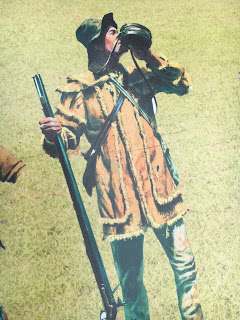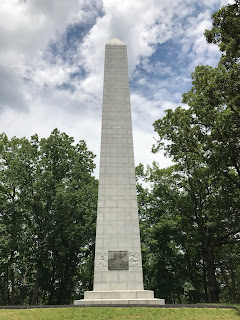Sarah Florida Day was born on November 5, 1878, in Magoffin County, Kentucky, to James Thomas Day and Nancy Emily (Reed) Day. The first census on which she appears is the 1880 census of Johnsons Fork, Magoffin County. She appears as "Sariah," age 1, along with her father, mother, and sister Ida, age 3. The next document in which she appears records her marriage as Florida Day to George T. Castle on January 2, 1896.
Her father, James Thomas Day, was born December 1st, 1856. I'm a little bit amazed that I have recently found a record of his birth on Ancestry. The columns in the birth register read: Date of Birth, Name of Child, Sex, Alive or Dead, Place of Birth, Father of Child or Owner of the Child, Maiden Name of Mother, Color of Child (White, Mulatto, or Black), Residence of Parents, and Remarks. Wow, that tells you right there that we are talking about a different century, and I haven't even told you about the Remarks column yet.
 |
| Kentucky Birth Record for James Thomas Day |
The record for "James Thos. Day" says that he was a male, born in White Oak, to parents A.J. Day and Sarah Jane Oney, and his parents resided in Morgan County, as did all the parents of the children registered on this page. I even know from this record the name of the midwife who attended his birth: Elizabeth Whitt. Isn't that amazing? I was pretty sure that's what I was looking at when I saw a woman's name under Remarks for each birth. Some of them were repeated many times. Then I noticed that the first listing under Remarks on that page said, "Sarah Hampton Mid Wife." Scrolling back, I found Elizabeth Whitt's name on the previous page with the initials "M.W." after her name. Think of all the women who served in that capacity over the centuries and never got any credit. At least these women did.
It has been easy to document J.T. Day's life in existing records. In 1860 he appears on the census of Magoffin County with his parents, A.J. and Sarah, and a little sister, Nancy, age 1. By the 1870 census his mother Sarah had died, and James T., age 14, is listed with father A.J., stepmother Catherine, sister Nancy, brother John R., and half-siblings, Mary and Sanford. (Records vary on John's date of birth, but on the 1900 census it is reported as April 1861. If so, Sarah was his mother.) James lost his mother at the age of 5, but he honored her memory by naming his second daughter Sarah, and that name has passed down through the Castle/Day family.
On April 13, 1876, James T. Day married Nancy E. Reed in Salyersville, Magoffin County. They went on to celebrate 55 years of marriage (their 50th was written up in the Tulsa papers) and had eight children: Ida; Sarah Florida; Zedda; Mary Emma; Cassa B. (the only boy, who died at the age of 4); Margaret; Minta; and Retta Lee.
 |
| 50th Wedding Anniversary, as reported in the Tulsa paper |
James Thomas, beloved by his wife, children, and grandchildren, died on November 28, 1931, just shy of his 75th birthday. I have always been touched (and somewhat horrified) by the following photograph. Of course, the family was only taking part in a tradition followed by most everybody, attending the body of a deceased loved one, but just look at their faces. You can tell how devastated they are.
 |
| I believe the girls are in order left to right by their ages: (L to R) Ida, Florida, Zedda, Emma, Margaret, Minta, Retta Lee |
All the records exist that make it possible for me to take the Day family back another generation. A.J. Day seemed to prefer the name Jackson in his early life or his initials later, but his death certificate gives his full name as Andrew Jackson Day. He first appears on the 1850 census at age 12, which would mean he was born around 1837/38, right at the end of Jackson's presidency.
A.J. Day married Sarah J. Oney on September 20, 1855. Just now in carefully looking at their marriage records, I have discovered a mistake in parentage that has been in my tree for quite some time. The marriage register reads:
"Married by me at the House of James Oney on the 20th day of Sept. 1855 Mr. Jackson Day to Miss Sarah Oney he aged 18 yrs born in Grayson Co. Va. she born in Tazewell Co. Va aged 15 years single present James Oney & Harvey Whitt Given under my hand this 20th day of Sept. 1855. Wm. Lykins MB Church"
For years I have shown the father of Sarah as William Oney from Floyd County KY who had a daughter named Sarah on the 1850 census. That Sarah wasn't actually even the right age to be our Sarah. However, with the added information in the marriage register that Sarah was from Tazewell County, Virginia, and that her wedding took place at the house of James Oney (usually the father of the bride), I searched for James Oney in Tazewell Co. in 1850.
James Oney was already in my tree with a connection to the Days. His wife was Rhoda Day, and they had a daughter Sally the right age to be Sarah. In 1860 James and Rhoda were living in Magoffin County KY, and they had a son named Creed F. Oney. If you read my post about the Days in Davenport, you will remember that I thought that James T. Day and family came to Davenport because of their connection to a minister named Creed F. Oney. At the time I thought they were cousins, but it looks like the connection was even deeper. Creed was James T. Day's uncle. Another connection seems to cement the deal. The other witness at the wedding--Harvey Whitt--was also originally from Tazewell County and his mother was Elizabeth Whitt, Sarah's midwife at the birth of her son James.
Sarah died at age 21 on March 15, 1862. A.J. Day remarried to Catherine Jane Reed on November 24, 1864, in Magoffin County. A.J. and Jane had three children of their own: Mary Margaret, Sanford Jackson, and Andrew K. Sometime between 1910 and 1920 the families of Mary and Andrew K., including A.J. and Jane, moved to Ohio. Andrew Jackson Day died in Warren County, Ohio, on December 16, 1921. His death certificate says he was born in North Carolina on May 3, 1835, and his father's name was Thomas Day.
 |
| Aunt Emma wrote on the back of this picture: "A.J. Day with 2nd wife" |
 |
| A.J. and Catherine J. Day headstone Lebanon, Warren County, Ohio |
Jackson Day, age 12, appears on the 1850 census of Morgan County, Kentucky, along with father Thomas P., age 46; mother (?) Margarett, age 34; Anice, 15; Itera, 7; John, 4; Clarinda, 2; Cale (female, apparently Cahala), age 1. Daughter Carrie A., age 18, was already married to James Wells. A lot of trees on Ancestry identify mother Margarett as Margaret "Nancy" McGrady--the Nancy because daughter Carrie's death register entry says that her parents were Thomas and Nancy Day. I have not found any documents that prove that Margaret and Nancy were the same person. Thomas's marriage in Grayson County, Virginia, on December 9, 1830, was listed in Early American Marriages, Virginia to 1850 , but his spouse is not named, at least not on Ancestry.
By the 1860 census Thomas P. Day's family had scattered. Fractured would be more like it. We talk about blended families now; we've got nothing on the 1800's when so many families were destroyed and rebuilt by the deaths of parents, especially mothers. Apparently, sometime not long after the 1850 census was taken, Margaret died. On March 8, 1852, Thomas remarried to Mrs. Mary Stacy--herself a widow. Thomas P. Day's household on the 1860 census looks like this: Thomas P. Day, age 59; Mary Day, age 45; Mary J. Peyton, age 3; Lucinda Peyton, age 1. What? What happened to Thomas's kids, and who are Mary and Lucinda?
Well, on August 4, 1851, Anice (spelled Annis) married Alfred Davis. Jackson married Sarah in 1855. On April 10, 1857, Itera/Itura married John Haney. Clarinda, age 14, is living with them on the 1860 census. John, age 16, is living with Carrie and her husband. On the 1870 census both Clarinda, age 24, and Cahala, age 21, are living with Carrie and James Wells. Some of this might just be empty nest stuff, but do you get the feeling that Thomas's kids don't like their stepmother Mary?
Mary is too old to have been the mother of Mary J. and Lucinda, and besides, their name would be Stacy, not Peyton. Going back to the 1850 census I found Mary, living with her husband, George Stacy. Their only daughter is Elizabeth. Elizabeth married Benjamin F. Peyton in 1856 and died of "fever" in 1859 at the age of 17, leaving behind two daughters, Mary J. and Lucinda. Mystery solved.
Thomas P. is living and listed on the 1870 census at age 66. "Keeping house" for him is Lurinda, age 48. I literally have no clue who she is. None of his daughters would be that old. Another wife? One more clue comes from the death certificate of Thomas's daughter, Annis. She died in 1921 at the age of 85. The death certificate says her father was Tom Day, and her mother was Nancy McGradia. I'm not deciphering that from somebody's handwriting; it is typed on the document. At least I know where the name Nancy McGrady came from.
 |
| Death certificate of Annis Day Williams |
"McGradia" is listed as a surname only twice on Ancestry--one might have been McGradie, and the other is our Nancy. I've found a couple of women on Findagrave with the first name of McGradia, but not one person with that surname.
Much of what I have learned about Thomas Day's parents comes from a biography of Joseph Day published in Carroll 1765-1815: The Settlements: A History of the First Fifty Years of Carroll County, Virginia by John Perry Alderman and posted by a kind Ancestry member with the cute username of cmyroots. Joseph Day was probably the son of Joseph and Susanna Day, who were listed as taxpayers in Montgomery County, Virginia, by 1782. Some users on Ancestry give Susanna's maiden name as Huston.
Their son Joseph was born in Pennsylvania about 1776 and married Rhoda Cock in 1796. The couple moved around some, living on a couple of tracts of land deeded to them by Rhoda's father, Andrew, and buying others. They also had ten children, according to Joseph's will: Robert, Penelope, Thomas, May, Theodota, Andrew, Rebecca, Joseph Day Jr., Rhoda (who married James Oney), and Hannah. The Carroll County book says this about Thomas: "Thomas Day married Nancy McGrady in Grayson on December 9, 1830; he did not live long in the county and many of his descendants are to be found in Kentucky."
Rhoda Cock died August 16, 1827. Joseph remarried a couple of years later to a much younger woman, Rebecca Dunn. (He was 54; she was 18.) They are found on the 1850 census in Carroll County. He is listed as 74, she as 38. Also enumerated with them are Rebecca's daughter Louisa from her first marriage, and their seven children: Lorenzo, Malissa, Peter, Commodore, James, Lucy, and John. Joseph died at about age 80; his youngest child was 8.
After reading about Grandpa Day's parents and grandparents, it makes me appreciate his 55-year devotion to Grandma Day even more!















































